TARS (Threat Assessment Reconnaissance System)
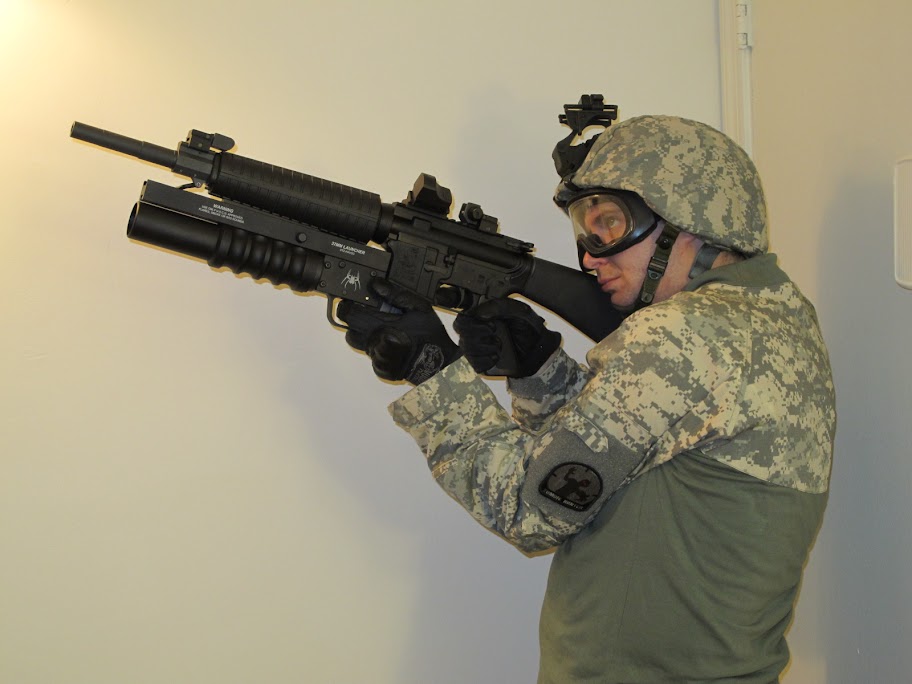
Project jointly developed by Josh (@quadling) and myself (@recompiler).
I got the idea for the system in May of 2011 as I was looking at some pictures taken from a high-power model rocket and comparing them to pictures I took from my high power model rockets years ago.
Electronics have come a long way since I last launched anything large and I was really anxious to have a mini-arduino or something similar instead of a small kluged together altimeter. I was also pretty sure I would be able to have a wireless video camera instead of a still camera with film I'd have to develop later.
There's all sorts of situations I wish I had a rocket with a camera on it. Everything from camping, hiking, HAM field day, urban exploring, paintball games etc. The down side to rockets is that the launch mechanism is cumbersome and unreliable.
I looked over at my Spikes Tactical 37mm flare launcher and I knew I had a solution.
The 37mm launchers are ATF approved life safety devices. They can be legally possessed by all law abiding US citizens in all 50 states.
As I thought about it more I realized that a system that launched a camera and sent images or video wirelessly would be great for Ground Search and Rescue teams. The local paintball and airsoft teams might also like to have this. As I thought more about this I realized the SWAT teams may also be interested in the system as the only system that even comes close to what I envisioned (firefly system) is over $2,000 a shot.
Few days later I was talking to Josh since he is an expert on camera systems and he got excited about the possibilities. Josh agreed it'd be a cool project and we got to work.
I had never fired anything other than commercially loaded smoke, flare, and CS out of my launcher before so I knew I had some research ahead of me. I had previously reloaded rifle and pistol rounds so I was comfortable with the idea. I had looked into reloading 37mm before and I remembered the ATF rulings and guidelines about what is and isn't a Destructive Device, I also vividly remembered the (blown off) hand of a guy who tried to load his own (likely illegal) binary firework mixture and had suffered the consequences.
The primary concerns during the design are safety and civilian legality without it being considered a destructive device.
The status of 37mm launcher is determined by several laws
* NFA 1934
* PC 120301(a)(4)
The quick and dirty summary is that 37mm launchers are given an exception from being a DD as long as they are used as a life safety or signaling device, aren't intended to be used or used for offensive purpose, and contain less than 1/4 ounce of explosive. The 1/4 ounce including the lift charge/propellant as well as the signaling charge whether thats a flare or aerial report.
Once my constraints were laid out and understood the design began in earnest.
Applications
* GSAR - The ground search and rescue teams have a very tough job. They are made up of dedicated, hardworking people who give up their weekends, nights and quality time with their loved ones to go out and help others in trouble. The civilian teams must deal not only with difficult terrain, environmental conditions but are also limited by the tools available to them. Much of the equipment is donated by military, often 20+ years old and bought and paid for by volunteers out of pocket.
Many GSAR volunteers already already own 37mm launchers for signaling. A reliable, affordable system that would allow teams to see over hazardous terrain would improve sector coverage, lead to faster rescues with less danger to the search team.
* HRT - Most jurisdictions do not have dedicated hostage rescue teams. SWAT teams are responsible for everything from high-risk search warrant execution to hostage rescue to event standby to dealing with riot situations. The SWAT teams already have 37mm and 40mm launchers and are well trained in their use. A system such as this could make the job easier and safer for SWAT teams as well as for those they serve.
* Military - Given the cost and ease of deployment the concept behind this system can hopefully be used to help save the lives of American men and women serving our country. The military already deploys 40mm launchers for a variety of rounds. Giving the ground troops an ability to instantly get an overhead view without the need for calling in drones, helicopters or fixed wing support. This may be useful for helping spot IEDs from a greater distance.
* Hobbyists - This is a great platform for DIY community that loves taking high altitude pictures, build rockets, launchable platforms, and arduino projects
* Private Contractors - In today complex world the private contractors are often doing force protection duties and fighting along side our troops. The contractors float in the gray world between civilian and military. They are asked to do the job of military with many of the same constraints and limitations faced by civilians. Few private companies have rotary wing support, and not a single company is fielding its own drones or satellites for real time battlefield intelligence.
* Riot Situations - In todays society riots often develop quickly with rioters organizing and communicating quickly via social networks. Police forces don't have real time intelligence to gauge the size, intentions or how armed the rioters are. The riot responders already have have 37mm and 40mm launchers for tear gas and rubber button dispersion. Having a launchable camera system will enable real time surveillance, allow for an appropriate and measured response and will be stealthier than rotary wing aircraft.
* Maritime Operations - Ability to arc a camera over a ship and observe onboard activity prior to boarding/search while maintaining a standoff distance.
* Urban/Disaster Rescue - During disaster rescue minutes are like a lifetime. A small portable system can help rescuers quickly spot survivors or identify likely locations where survivors may be trapped
* Surveillance - One of the variants being developed is well suited for surveillance/on-station operation. The camera package is equipped with numerous tangle lines instead of streamer.
The intent is to have the camera package to be inserted at a higher velocity and to get tangled in tree branches, brush etc near the point of interest. Due to subsonic velocities the camera package is very stealthy and quiet in flight.
Goals
* Safe - who doesn't want to keep all their fingers?
* non-DD - ease of use, ease of transfer, legality in all 50 states, reduces administrative hurdles
* Reliable - a life-safety device is useless if you can't rely on it
* Waterproof - Waterproof capsule allows for an environmentally stable package that can survive the launch and has on-station potential
* Durable - The camera capsule and recovery mechanism must be able to withstand initial shock delivered by wading that is hit by hot expanding gasses.
* Cheap - needs to be easily affordable by civilians
* Low Recoil - can be fired by small stature individuals, must not scare them into not wanting to fire it ever again, avoid injury to rescuers repeatedly firing the device throughout the day.
* Standard Hardware - Can be used from standard 37mm and 40mm launchers, system requires only shells and receivers. Using COTS allows for lower costs and for rapid development/prototyping.
* Altitude - Minimum useful height was calculated to be 70 feet. The intent was to be able to clear over trees in pine barrens as well as to clear 5 story buildings with a bit of room to spare in an urban environment.
Based on aerodynamics of camera package, weight, propellant charge, parachute and streamer the max achievable height was calculated to be in excess of 400yds, fired in an arc at 50 degree angle.
* Range - Based on current design max range was calculated to be around 600 yards, with no wind when fired in an arc at 50 degree angle.
Design
* Shells - Reloading once fired used shells is a pain in the ass. I found a company that produces great reloadable shells. The shells are thick and sturdy, very easy to work with, very easy to reload. The walls are thick enough that I don't keep seeing the image of a mangled hand in my mind when I work with them. The company ships their products FAST and is great about providing load data and doing custom CNC machining and modifications.
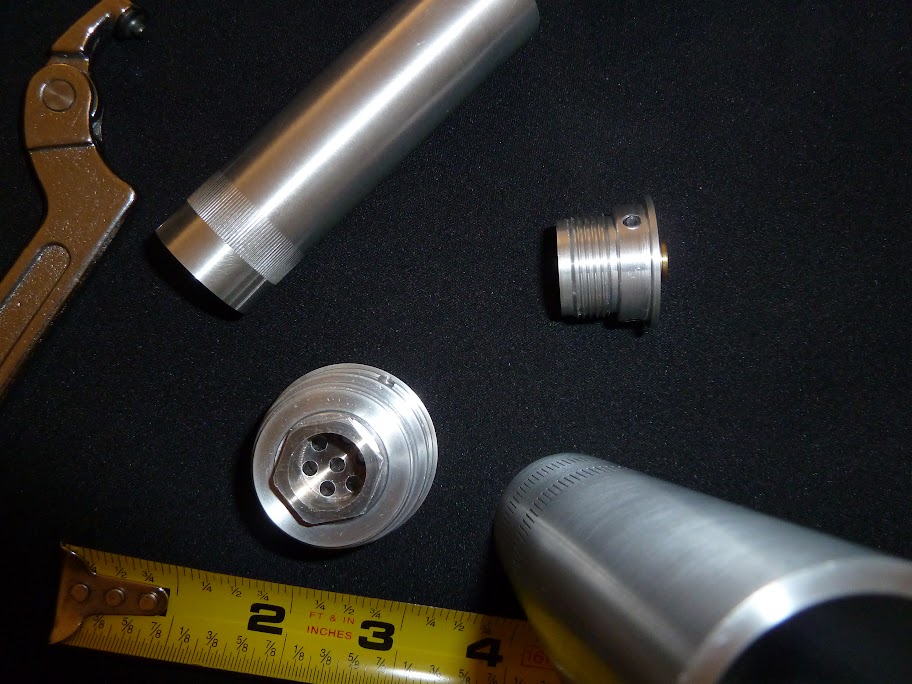
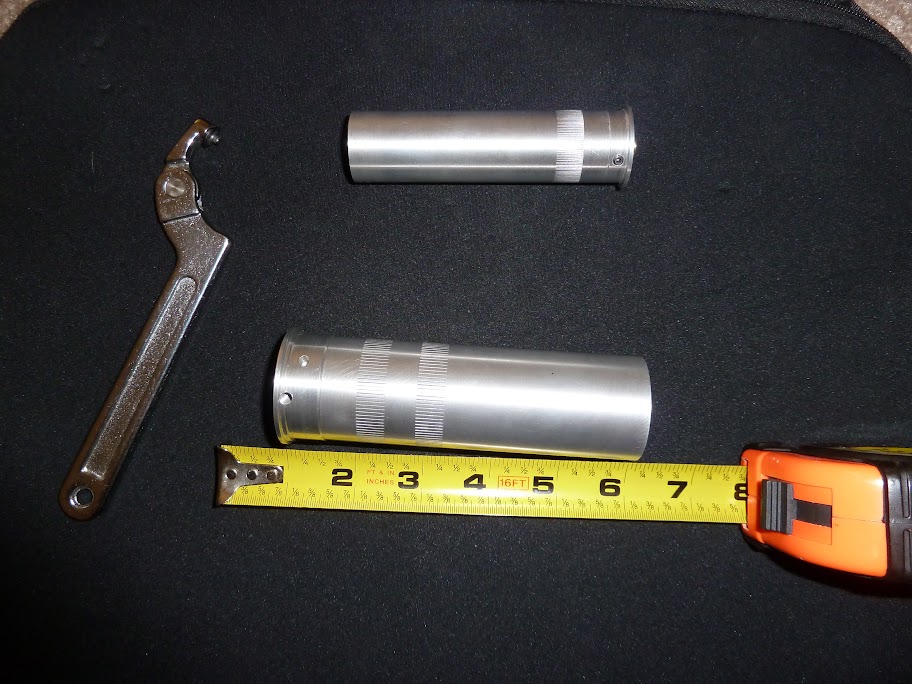
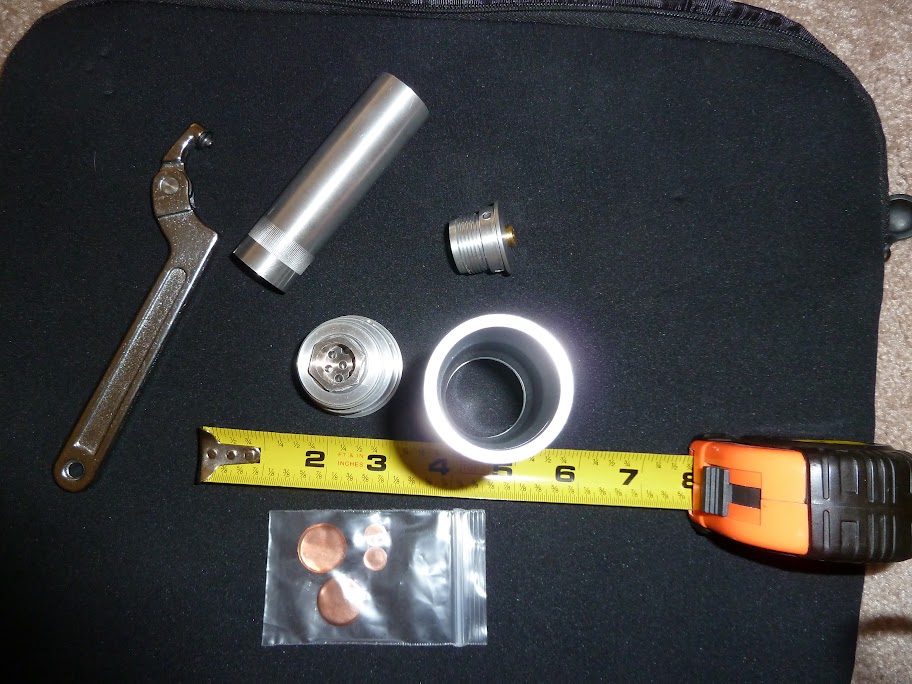
Disassembled shells and copper burst disks.
* Loading - When I started out the project I wanted to stay at least 20% below both legal and safety thresholds for the amount of propellant. The camera capsule contains only electronic/reconnaissance package. All the powder is in the high pressure chamber. This loading max was the basis for all my calculations from that point on.
The shells we are utilizing use a highpessure/low pressure system design. The burst disk controls the maximum pressure reached in the pressure chamber, the size of the vent holes controls the pressure in the low pressure chamber
* Payload Package - I experimented with various payload packages. Initial tests were conducted with 35mm film canisters. Initial tests were positive however it quickly became apparent that the containers were not aerodynamically stable enough, and were spacious enough to accommodate the appropriate power source.
Further testing was done with nalgene mini bottles. At this stage the most promising candidate is the baby soda bottle.
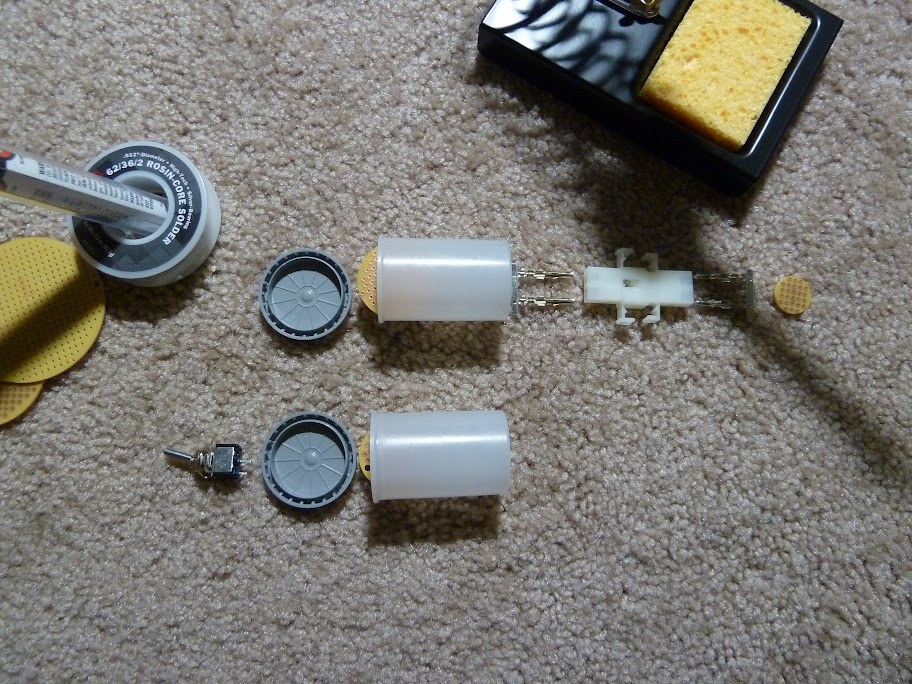
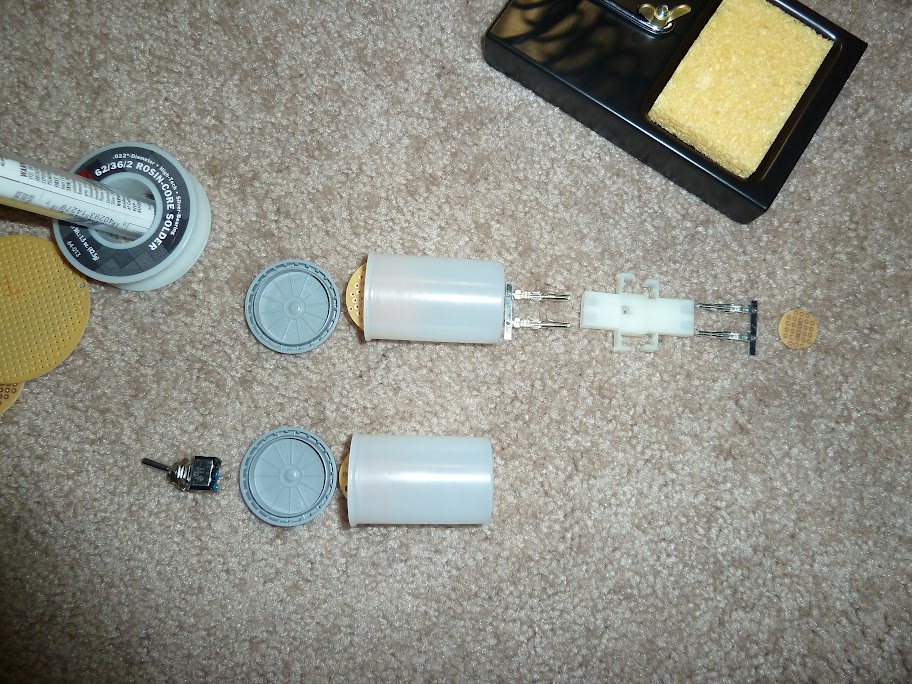
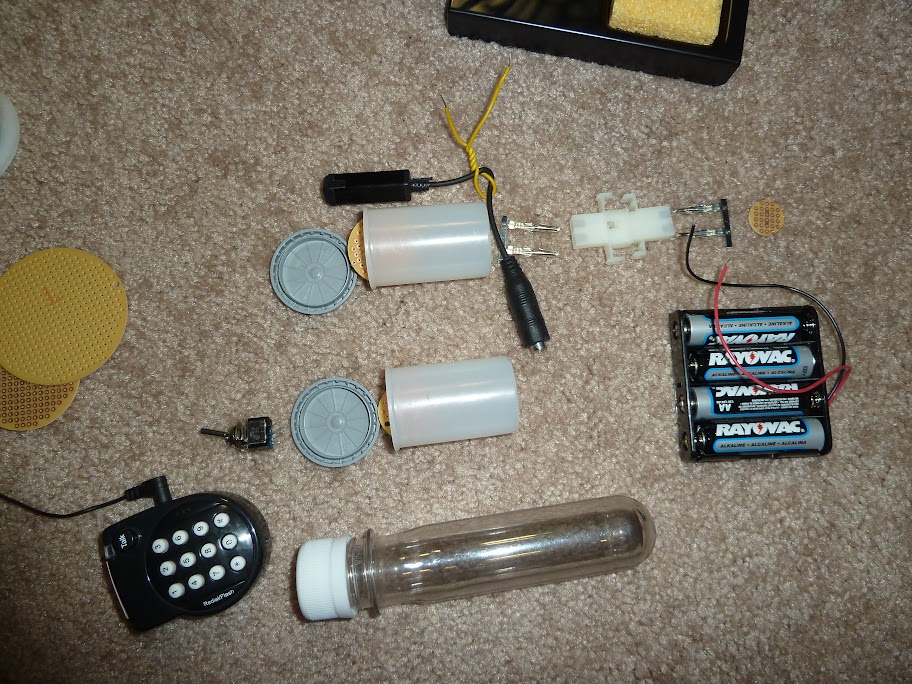
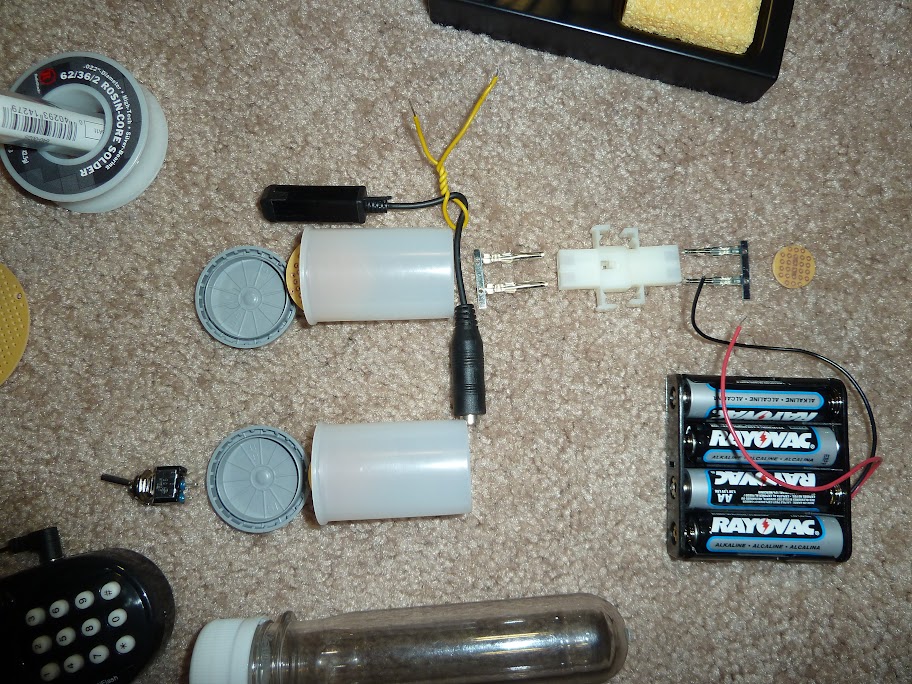
Some pictures of various test capsules being prepared for assembly.
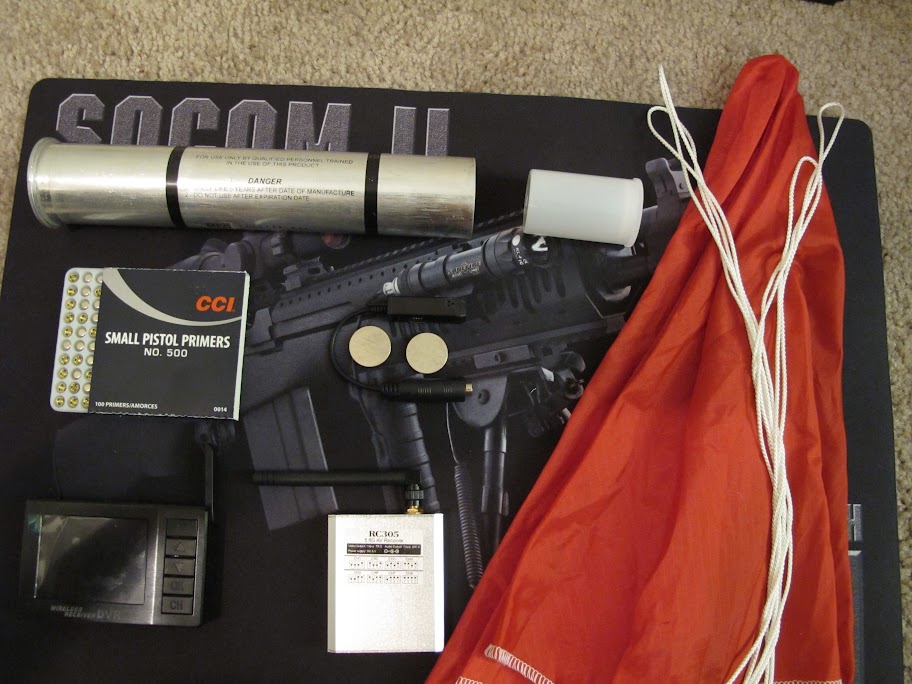
Top left - empty casing from a 37mm batton round. I was attempting to reload it with the camera round but the primer was a pain in the butt to load, and the thin walls made me scrap that idea.
Bottom left - tactical DVR with LCD. To the right of it is the cold zone/command post receiver.
Above the cold zone receiver is the camera module with connector prong, 2 button cell batteries are between the wires.
Far right - parachute that ended up being way too large for the capsule, also parachute is too large for the capsule weight and anticipated wind.
* Stabilization - Initial design called for spring-open fin design. While great in on the whiteboard, reliably deploying fins while the system is fired under variety of conditions and at variety of angles.
The initial great design was sidelined for now in favor of designs that utilize streamers. Streamers not only stabilize the camera but also help slow it down to a velocity where the camera output can be easily perceived by unaided eye without needing to rewind and rewatch video several times.
* Deceleration - The camera is initially fired at a fairly high velocity (>650fps) while quite slow for a round it is way to fast for a video camera. The camera gains altitude during the boost phase and must then be slowed down to a point where the camera can keep up.
The main deceleration is accomplished with a small fire-resistant parachute. Initial designs utilized a larger parachute but the deployment proved to be less reliable and too space inefficient.
The parachute also ensures the camera is properly oriented to send back video shortly before the apogee, and the entire time of descent.
Slower velocities help make the round safer for use around crowds and particularly unsuitable for anti-personnel use and help reinforce it's non-DD purpose and legal status.
Once the chute is deployed the camera capsule is slowed down to < 250FPS.
* Arming - Once the power is applied the camera is live, and broadcasting video.
Needless to say this was unacceptable due to low battery lifetime. We needed an arming mechanism. The M203 uses a spin-arm mechanism. While very cool concept it is unreliable and totally unfeasible for our civilian smooth-bore barrel.
I experimented with various designs including reed switches, magnets, arming plugs, keyed arming plugs, push switches, pull-pin/ripcord designs. An acceptable solution that allows for the capsule to remain waterproof, reliable, and for the camera to be activated prior to be firing is yet to be worked out.
Some testing was done with mini-arduino and 3 axis accelerometer. While working and cool it is not feasible in 37mm version due to power requirements and space constraints. I am sidelining this possibility (for now).
* Cameras - Camera systems are Josh's specialty and he has been working on various possibilities. After some trial and error 5.8GHz spectrum was decided upon. Range was tested to 350ft in urban environment.
* DVRs - After some research josh has settled on a 2 prong approach - a tactical receiver which can be worn on the arm band, attached to hook and pile etc by the tactical team. The tactical receiver records to a high capacity micro SD card for replay and evidentiary purposes.
The 2nd receiver is a high-power long range receiver with standard AV out. this unit would be placed in the mobile command post/cold zone.
Josh's blog - geekgunner.com/blog/2011/law-enforcement/37mm-camera-launcher
Josh and I are the only ones currently working on the project and are the only definitive sources of information about the project.
DEFCON19
We had the pleasure of presenting at DEFCON 19. The PDF Version of our presentation is available here. If you need the ppt version email us with a good reason and we will consider it.
BSides LV and DEFCON Presentation in the news.
Some stories are more accurate than others. I'd like to commend some journalists for taking he time to speak to us and get the facts. In fact there was only 1 journalist who spoke to Josh and I in person.
I would also like to thank Oleg Volk who took the photographs featured in all the stories.
I'd also like to point out some stories that... well I am not sure where they got their information from but they certainly didn't speak to us, didn't listen to the presentation and didn't flip through the slide deck...
http://www.arnnet.com.au/article/396350/build_your_own_camera_launch_it_like_grenade/
http://www.cio.com/article/687365/Build_Your_Own_Camera_Launch_it_Like_a_Grenade
http://www.cio.com.au/article/396350/build_your_own_camera_launch_it_like_grenade/
http://cio-asia.com/tech/security/build-your-own-camera-launch-it-like-a-grenade/
http://www.computerworld.com/s/article/9218962/Build_your_own_camera_launch_it_like_a_grenade
http://www.techworld.com.au/article/396350/build_your_own_camera_launch_it_like_grenade/
http://hardware.slashdot.org/story/11/08/08/0354228/Build-Your-Own-Camera-Launch-It-Like-a-Grenade
http://www.techworld.com.au/article/396350/build_your_own_camera_launch_it_like_grenade/
http://www.networkmirror.com/OIhtu2pQS35a635D/www.techworld.com.au/article/396350/build_your_own_camera_launch_it_like_grenade/index.html
http://creativecentury.com/hot-news/military-inspired-camera-launcher-can-give-you-perspective-on-your-surroundings-yahoo-news.html
http://currentnewstoday.info/2011/08/10/military-inspired-camera-launcher-can-give-you-perspective-on-your-surroundings/
http://www.decksharks-records.com/military-inspired-camera-launcher-can-give-you-perspective-on-your-surroundings/
http://www.dnewstoday.info/193/military-inspired-camera-launcher-can-give-you-perspective-on-your-surroundings.asp
http://www.gadgetsgeek.ly/2011/08/10/military-inspired-camera-launcher-offers-better-look-at-surroundings/
http://gadget-reviews.findtechnologynews.com/military-inspired-camera-launcher-offers-better-look-at-surroundings/
http://www.newsbulletins.org/military-inspired-camera-launcher-can-give-you-perspective-on-your-surroundings-yahoo-news.html
http://www.newsgadgets.net/military-inspired-camera-launcher-offers-better-look-at-surroundings.html
http://www.vexa.org/1753/military-inspired-camera-launcher-can-give-you-perspective-on-your-surroundings/
http://www.worldbulletins.com/military-inspired-camera-launcher-can-give-you-perspective-on-your-surroundings-yahoo-news.html
http://newsperuse.com/military-inspired-camera-launcher-can-give-you-perspective-on-your-surroundings-yahoo-news.html
http://recentnews.eu/military-inspired-camera-launcher-can-give-you-perspective-on-your-surroundings-yahoo-news-2/
http://www.newsinformed.com/technology/military-inspired-camera-launcher-can-give-you-perspective-on-your-surroundings-yahoo-news
http://www.dotnetz.net/index.php/?p=13046
http://www.extremetech.com/extreme/92192-home-made-grenade-launcher-digital-camera-shown-off-at-def-con
http://www.geekosystem.com/diy-camera-launcher/
http://www.geeksaresexy.net/2011/08/09/now-thats-what-i-call-a-point-and-shoot-camera/
http://geeks.thedailywh.at/2011/08/08/camera-drone-launcher-gun-of-the-day/
http://www.geek.com/articles/geek-cetera/the-firefly-is-a-military-grade-grenade-launcher-that-shoots-a-wireless-camera-2011088/
http://gizmodo.com/5828751/build-a-military+grade-camera+flinging-grenade-launcher-for-500-bucks
http://www.sync-blog.com/sync/2011/08/modified-flare-gun-aims-to-launch-a-wireless-camera-75-meters-in-the-air.html
http://techcrunch.com/2011/08/08/hackers-show-diy-defense-and-disaster-response-gear-at-defcon/
http://www.washingtonpost.com/business/technology/hackers-show-diy-defense-and-disaster-response-gear-at-defcon/2011/08/08/gIQAbmiu2I_story.html
http://techshadez.ishadez.com/tag/marpet/
http://todaysdefense.com/?p=6059
http://todaysdefense.com/?p=6153
http://tech.wiredpig.us/2011/08/flare-gun-drone-launcher/
Lets dispel some common inaccuracies and address some points that were brought up.
One common mistake I see in many of the stories is the statement that we are using a grenade launcher - we're not. We're using a flare launcher.
The difference is both technical and legal. The grenade launcher is 40mm, uses a rifled barrel, and is registered as destructive device.
A flare launcher is 37mm, uses smooth bore barrel and requires no registration and legal in all 50 states
Another common inaccuracy is that we're using a modified flare launcher. This incorrect, absolutely no modifications have been made to the launcher. This was part of the design.
Q&A
Q: Why use 37mm launcher and not compressed air?
A: Significant portion of intended audience already has 37mm and 40mm launchers. They are easy to use and there's no learning curve.
The intended audience is already carrying 60+lbs of gear and making them carry a whole other system might make it not feasible.
Legal status - the 37mm is already designated as a life safety device by ATF, many of the potato guns etc are actually technically illegal under federal law and in many jurisdictions.
The air tanks would produce a slew of challenges to recharge during disasters. The shells are self-contained.
Q: The air tanks are heavy and can become a hazard under certain conditions. Ruptured pressure hoses can whip around injuring the operator. Cracks near the stem can turn the tank into a dangerous projectile.
A: Why not use camera x or y that costs $8 and uses SD card?
First of all SD card cameras are unusable as they would require the recovery of the camera to review - which defeats the whole purpose of using a launchable camera system.
Q: Why not use a cheap helicopter?
A: Helicopters take a bit of time to learn to control and fly properly. Helicopters are actually the hardest type of aicraft to fly.
Consumer grade helicopters, even when expertly flown are very noticable and easilly detered or dissabled.
We conducted a few tests
Test 1
One test involved an electric RC helicopter attempting to sneak up on me from 200 yds away. I was entrenched and behind a barricade. The helicopter could be easilly heard from 30+ft away. The helicopter was easilly shot down in 3 shots with a semi-auto tippmann 98. Paintballs fired at 320 FPS ripped through the airwolf body, displaced the motor and collapsed the blades.
Test 2
We attaempted to have a gas powered RC helicopter sneak up on an entrenched position on painball field - craft was audible almost immediately
37mm vs 40mm
Upgrading from 37mm to a 40mm launcher would offer a number of benefits. Being a destructive device, I wouldn't be limited by weight of propellant to be used. Increased propellant would allow for longer range, higher altitude, and more time for stabilizing the round in the air. The 40mm launchers are civilian legal in most USA states.
The downsize to upsizing to 40mm is that even in states where DDs are legal they are still regulated by ATF. Each 40mm must be registered ($200 creation/transfer tax). The 40mm can't be quickly and readily transfered person to person as needed. The 40mm launcher also has a different perception - it's a weapon not a rescue device. I do not own a 40mm launcher and do not intend to purchase one in immediate future so that would complicate testing.
Most 40mm launchers can readily fire 37mm shells. Any shell loading appropriate for a non-DD 37mm can be directly applied to 40mm shells.
By limiting the availability and easy access to TARS we would be going against the original intent of this project. At this time no 40mm shell loading are being developed.
V .1 (Limited Success)
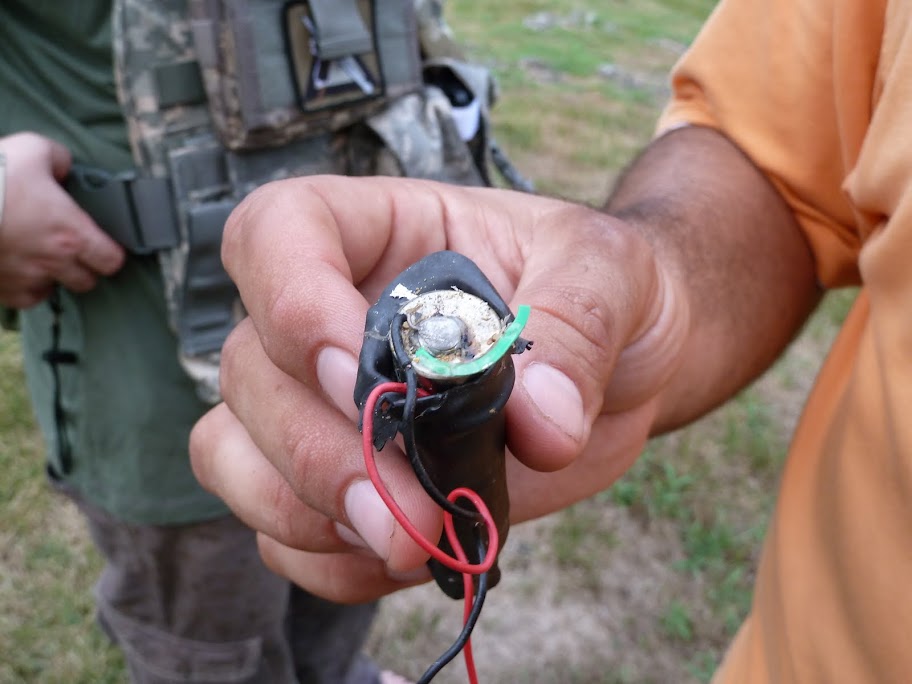
Sometimes things work - other times the wadding isn't seated properly, the parachute singes and the battery pack gets hammered.
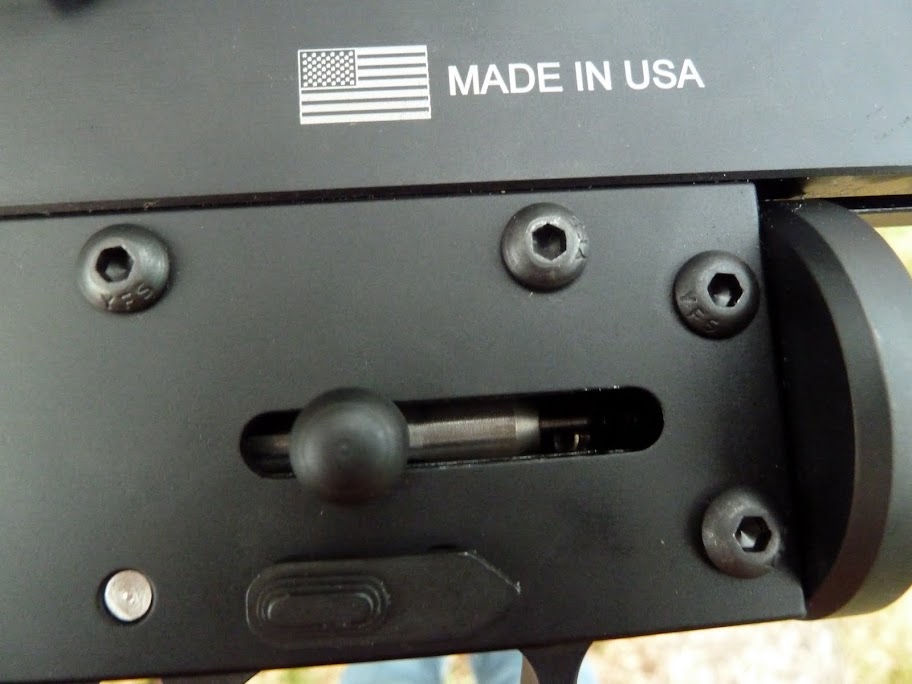
One of the weirder failures we experienced was a primer coming loose, falling inside the firing mechanism and jamming the firing pin.

Loading a shell for firing.
V .2 (Currently in Development)
I got my hands on some micro arduino and mini arduino samples which should be able to survive the shock of the launch. The power usage is only 3v for 16Mhz which means even 1 N battery will keep it well fed for the launch, flight and some time on station.
The reason for the arduino is I am experimenting with some sensors - 3 axis accelerometer, chemical sensors, and a radiological sensor. The sensor uses a cheap PIN Photo-diode instead of expensive Geiger-Muller Tube to detect beta and gamma radiation. The projectile can be fired over a suspected contaminated area to get a better more accurate reading and to evaluate the level of protective equipment needed by responders.
We hope to test V .2 within next 2 weeks.

Micro arduino, 2 radios for telemetry communications, 3-axis accelerometer.


Looks like a good fit for our capsule! We're in business!!
Loading Data
I am struggling with how much and how to release this information. I have developed a lot of simulation data, pressure/loading tables, air resistance, drag etc based on mass and mass distribution of the projectile being fired. A few cool simulations were written, as well some open source rocket simulators written in C/C++ were modified. I want to keep this project as open as possible however we live in a litigious society and I don't want to be responsible for someone miss-applying my data or instructions. For now I will provide this on a per-request basis.
Thank You
I'd like to thank everyone who helped on this project.
- My girlfriend that has put up with weeks and weeks of shell loading, smells of soldering and circuit boards at 3am
- Josh for working with me on this project
- My friends that helped with the testing
- The farmer who let us do test launches on his 90 acre farm, over a pasture filled with next months burgers.
Contact Me: recompiler at gmail dot com or @recompiler.